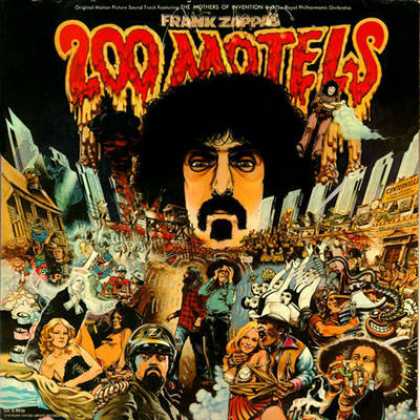
200 Motels is a 1971 American-British musical “surrealistic documentary” featuring Frank Zappa and The Mothers of Invention, produced at the famed Pinewood Studios, England. Directed and written by Frank Zappa and Tony Palmer, with special material written by Howard Kaylan, Mark Volman, and Jeff Simmons. Actors included Ringo Starr, Theodore Bikel and Keith Moon. A double album of the soundtrack was released in the same year.
The US$679,000 film budget resulted in a seven-day shoot and eleven days of editing. Its low production values and frenetic schedule contributed to the insanity which the film attempted to evoke. Although the film’s main theme is “life on the road” for a touring rock musician in the late twentieth century, it makes broader comments about the surreal state of the political and cultural life of America and the world during that time.
Its references include Mephisto, Kafka, Kubrick’s 2001, work re-education/concentration camps and an animated sequence with a cameo of Donald Duck featured as part of a video/musical collage. These broader, symbolic culture references coexist with specific characters and places: i.e. “Lonesome Cowboy Burt”, a non-union roofer who savagely beats up hippies and leftists, and two groupies, Lucy Offerall (of the The GTOs) and Janet Neville.
The film’s creative talents include the Mothers of Invention and the Royal Philharmonic Orchestra, the actor Theodore Bikel, and rock-stars Ringo Starr (playing Larry the Dwarf) and The Who’s drummer, Keith Moon (in drag, playing a nun).
The plot is both nebulous and nonexistent as a narrative or as a series of vignettes and production numbers. According to Zappa, only a third of his script was filmed. The director, several actors and a band member quit mid-production. These events accounted for several radical, last-minute changes.
To keep costs down, the film was shot and edited entirely on 2 inch Quadruplex videotape in the PAL format and only transferred to film after post-production was complete, a cinematographic first. The rushes and the unused scenes were later erased and sold as used bulk video tape.
200 Motels was negotiated by United Artists in England as the first “feature length videotaped motion-picture” according to Frank Zappa during a lecture held on April 23, 1975 at the Gifford Auditorium, Syracuse University. No feature length music-video had ever been attempted before. Zappa greatly preferred their more advanced 625 line system with a higher resolution which allowed the separation of the three basic colors R,G,B, combined with Technicolor made a better looking color tape than the standard American tape at the time. The set was on ‘Stage A’ where Stanley Kubrick had filmed the special effects.’2001: A Space Odyssey’ and during the same time as the production for the approximated 22 million dollar ‘Fiddler on the Roof’. Each of the seven days of production were strictly limited to exactly 8 hours per day to the minute including two, 15 minute tea breaks. However the 150 plus on stage cast (including a live-performing 120 member orchestra which had not been attempted since the 1930s) often over-ran these tea breaks costing a total of about 4–5 hours production time in their brief 56 hour shooting period. The eleven days of editing consisted of 10 hour days of videotape edit in which negatives were transferred to film, and an additional 3 months in post-production including all the dubbing and sound effects, during this process the film was shortened from the original 220 minutes down to the eventual running time of about 108 minutes, and then a final dub.
200 Motels (soundtrack)
The music on the soundtrack is in a different sequence than the film. In addition, Zappa explained in the soundtrack album notes that, not all the music in the film is on the album, and not all the music on the album is in the film. Some of the music written for the project is not in the movie or on the soundtrack album.
This was not the first time that Zappa combined orchestral and rock music on film. He did this in his very first film score The World’s Greatest Sinner in 1962. The music in 200 Motels also has similarities to earlier Zappa works, such as the orchestral score to Run Home Slow (1965) as well as his first solo LP, Lumpy Gravy, from 1968.
The double album soundtrack, like the film, was completed in a week. The production took place at Pinewood studios in England and the recording of the band without the orchestra took place after the day’s filming was complete. This was done with a rented remote recording studio/truck owned by the Rolling Stones which was driven into the movie studio and parked there for a week.
A large variety of musical styles and satirical parodies of musical styles on the album, including the faux country “Lonesome Cowboy Burt” with a vocal by Jimmy Carl Black. Rock band selections include “Do You Like My New Car”, “Shove It Right In” and “Magic Fingers”. Little space is given to guitar solos on the album and lyrics throughout the album are typically obsessed with sexual behaviour, critical of American society.
Zappa’s orchestral compositions exhibit the influence of composers he admired such as Varèse, Stravinsky and Webern. The soundtrack also includes operatic vocals by a group of “serious” singers on some pieces and the entire panoply of modern chamber music, twentieth century orchestra, avante-garde and twelve-tone repertoire are also represented on the soundtrack.
